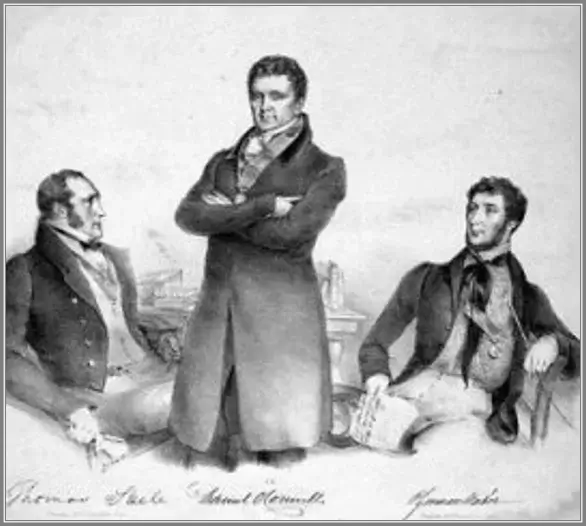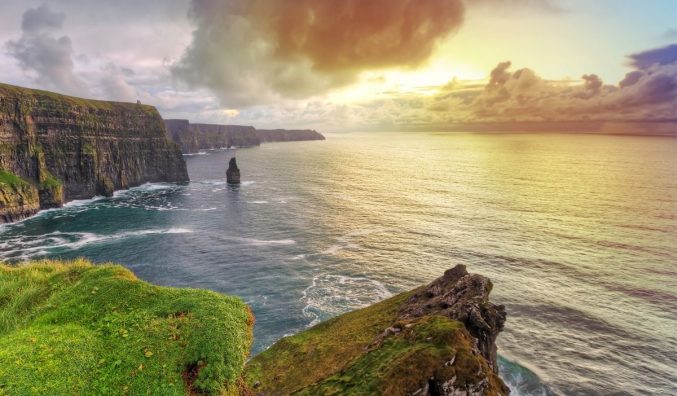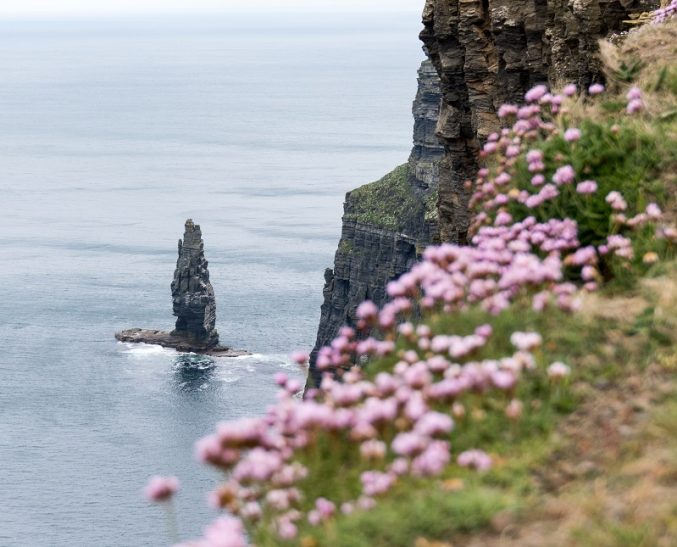
History
Hags Head was the site of an Iron Age fort built in the 1st Century BC.
This fort gives the Cliffs their name as the word “Mothar” in ancient Gaeilge means “ruined fort”.
Spanish Armada ships fleeing Elizabethan forces are driven around the north and west of Ireland by storms. Many ships are wrecked along the coastline. Boetius Clancy, High Sheriff of Clare, spies two Armada ships from his lookout atop the Cliffs of Moher. He has been issued orders by the Lord Deputy to “apprehend and execute all Spaniards found there of what quality so ever”.
There are locations along the coast reputed to be the execution and burial sites of the doomed Armada sailors.
Cornelius O’Brien is born in Birchfield, Liscannor, Co. Clare.
Signalling tower built at Hag’s Head by British Army during Napoleonic Wars (1803–1815) as a lookout post. The earlier promontory fort, known as Mothar or Moher, which gave the Cliffs their name was demolished to provide material for this new signalling tower.
Cornelius marries Margaret Long and begins renovation of his home in Birchfield, Liscannor.
Cornelius O’Brien as chairman of the election committee selects Daniel O’Connell as candidate for the famous 1828 Clare Election.
On December 1st, Cornelius O’Brien is elected MP for Clare. He held his seat in Westminster from 1832 to 1857, losing only once, in 1847. Advancing age and ill health forced his retirement from parliament in March 1857, two months before his death.
Observation tower is completed, this tower later became known as O’Brien’s Tower.
A bridge is built over the Inagh river joining Lahinch and Liscannor. This bridge would allow easy passage for Victorian visitors making their way to the Cliffs of Moher. It also gave easier access to local farmers to collect sand and seaweed during this prefamine era.
St. Brigid’s National School is built by Cornelius to provide education to his tenants’ children. He also erected a little Gothic structure over the nearby Reliever’s Well.
O’Brien became a voluntary member of the Liscannor Famine Relief Committee which provided relief work to impoverished tenants whose crops had failed.
On October 5th an article in the Clare Journal written by “an English Visitor” heaps praise on Cornelius O’Brien for his developments at the Cliffs of Moher – the tower, pathways, stables, round table etc. and even the provision of a piper to entertain the visitors.
On 30th of May Cornelius O’Brien dies. He is buried in his family mausoleum located at St. Brigid’s Well in Liscannor.
Tourism has become a feature of the local economy. In “Two Months in Kilkee” written by Quaker Mary Scott, in the 19th century she describes climbing “Hag’s Jaw” near the Cliffs of Moher while “the little girls from the cabins nearest to the top, followed the travellers with dishes of potatoes smoking from the pot, and butter or milk”.
After a period of time in the United States, Denis (Dinny) McMahon returns to his home townland of Ballysteen neighbouring the Cliffs of Moher.
In the late 1950s he sees an opportunity in the growth of tourism at the Cliffs of Moher and in his own words “I started off talking to people. I wore a guide badge to draw their attention. We have a lot of wildlife there and I’m a fairly good ornithologist. I am good on rock formations and very good on history and God only knows all the stories I have.”
Dinny also plays the tin whistle for tourists, continuing the longstanding musical traditions of the area and he becomes a well-loved part of the attraction of the Cliffs.
A German industrialist Eberhard Kemper makes an offer to the Considine family to buy 65 acres of land at Lislorkan North. The lands included half a mile frontage of the Cliffs of Moher and O’Brien’s Tower (now in ruins). Clare County Council as a result of a tip-off intervenes and following negotiations with the Considine family completes the purchase of 2 acres & 25 perches for a sum of £1,060. Essentially this was the site of O’Brien’s Tower and the land fronting the cliff edge.
This transaction enabled the Cliffs of Moher to be developed as an amenity area for the benefit of the general public.
O’Brien’s Tower which had fallen into a ruined state is restored and reopened as a visitor centre and craft shop. Local man Joe Vaughan, is the curator. Tourists from near and far again enjoy the view which was first experienced by the guests of Cornelius O’Brien well over a century before.
The regional tourist board Shannonside Tourism, builds a stone building housing gift shop, tea rooms and toilets on the site of the old stables built by Cornelius O’Brien. By 1978, 100,000 visitors are coming to the Cliffs of Moher each year. Over the next ten years this number will increase to 250,000 and the volumes continue to rise throughout the 1990s.
Under the auspices of the Royal Institute of Architects of Ireland (RIAI) a national architectural contest is staged by the local authority, Clare County Council, to find a design for a new visitor centre at the Cliffs of Moher. In 1992 the contest is won by Cork firm Reddy O’Riordan Staehli Architects (RORSA) with an innovative design that sees the visitor centre hidden beneath the hillside to reduce any visual impact on the visitors’ view of the Cliffs.
New Visitor Centre opens, same centre remains in place still welcoming and educating people today.
O’Brien’s Tower is renovated again.
The Burren and Cliffs of Moher are awarded UNESCO-recognised Global Geopark status in 2011. Geoparks are special regions with outstanding geology and local culture that support sustainable development, research, education and cultural heritage by working closely with local communities, agencies and businesses. The work of the Geopark together with local tourism businesses committed to making the area a premier worldwide destination for responsible tourism continues today.
O’Brien’s Tower renovated; lime render returned to the outer walls to restore the look it would have had when originally built.

Cornelius O’Brien
Cornelius O’Brien was the third son of Henry O’Brien and Helen O’Brien, née O’Callaghan. He was born in 1782 at Birchfield, Liscannor, Co. Clare. In 1816, he married Margaret Long from Waterford. As a young man he was educated in the town of Ennis in the county of Clare where he studied Virgil, Grammar, Ovid and Corderius. O’Brien continued his education at the King’s Inns, Dublin, and went on to become a proctor, solicitor and magistrate for County Clare. He held a seat in Westminster as Member of Parliament from 1832 to 1857, losing only once, in 1847.
Cornelius O’Brien was quite a wealthy man. As a landlord he owned approximately 10,000 acres of land. He lived in Birchfield House near the Cliffs of Moher, built before 1816. Throughout his life he fostered a great appreciation of the Cliffs of Moher and saw great potential for tourism in the area. In 1835 he built O’Brien’s Tower to accommodate visitors who could then get enhanced views of the Cliffs. It is said that he would bring guests to the tower for entertainment. O’Brien’s Tower is technically termed a folly. Along with the tower, he built a holding wall, pathways, a stone picnic table on the cliff edge, and a stable complex to accommodate visitors. Liscannor flagstone was central to his building initiatives.
O’Brien was known to be a benevolent landlord who provided financial assistance to tenants to improve their farms. O’Brien wished to enhance the educational prospects of the locality and built a school in 1845. He was a visionary, with a view to alleviating and improving people’s journeys through the area. He facilitated the building of O’Brien’s Bridge between Lahinch and Liscannor. During such difficult famine-stricken times, he aspired to enhance and embrace the value of community by developing Gothic styled Refreshers Wells, and the rustic seating area and well house at St. Brigid’s Well. O’Brien is considered the forefather of tourism at the Cliffs of Moher, enabling the surrounding area to thrive. He died in 1857 and was laid to rest in a family mausoleum behind St. Brigid’s Well. A column was erected (1858-9) by public subscription in memory of Cornelius O’Brien.

Atlantic Tales
Cornelius O Brien with Clare FM
Hear more from Ciara Carew, interviewed by Pat Flynn, a Clare Broadcast Journalist.

Feel the textures of the past
Quarrying of the flagstone that is native to the Cliffs was a thriving industry in the 19th and early 20th century. The quarries were very prosperous and as a result, a village was built around the Doonagore mines.
The industry, which employed about 500 men, put Liscannor on the map as a busy port shipping stone to London and Liverpool – but with the coming of World War 1, the mines closed.
Then in the 1960s a few mines reopened in Liscannor and continue to produce their famous stone today – solid proof of the Cliffs’ rich heritage and status as a geological wonder.

